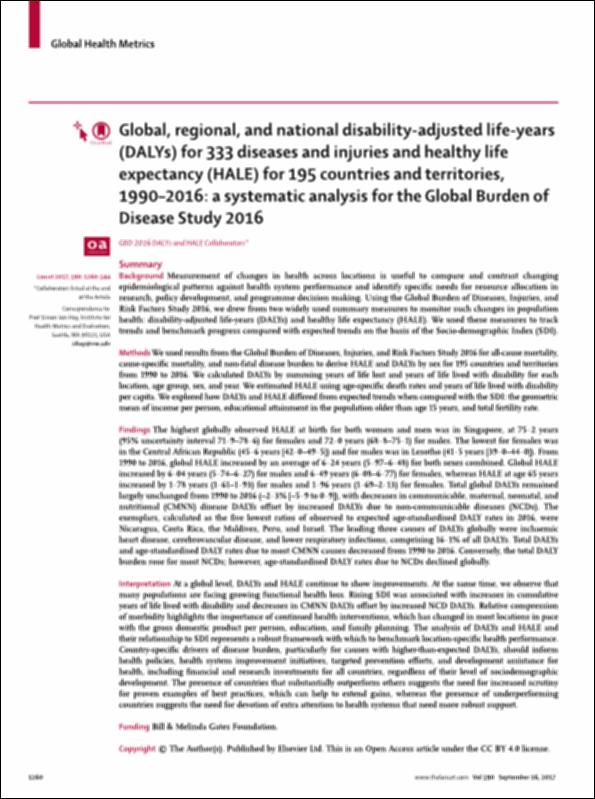Por favor, use este identificador para citar o enlazar este ítem:
http://hdl.handle.net/10637/11803Global, regional, and national disability-adjusted life-years (DALYs) for 333 diseases and injuries and healthy life expectancy (HALE) for 195 countries and territories, 1990-2016 : a systematic analysis for the Global Burden of Disease Study 2016
| Título : | Global, regional, and national disability-adjusted life-years (DALYs) for 333 diseases and injuries and healthy life expectancy (HALE) for 195 countries and territories, 1990-2016 : a systematic analysis for the Global Burden of Disease Study 2016 |
| Autor : | Martínez Raga, José |
| Autor : | Hay, Simon I. |
| Materias: | Discapacidad.; Esperanza de vida.; Disabilities.; Diseases - Analysis - 1990-2016.; Enfermedades - Análisis - 1990-2016.; Life expectancy. |
| Editorial : | Elsevier |
| Citación : | GBD 2016 DALYs and HALE Collaborators. (2017). Global, regional, and national disability-adjusted life-years (DALYs) for 333 diseases and injuries and healthy life expectancy (HALE) for 195 countries and territories, 1990-2016 : a systematic analysis for the Global Burden of Disease Study 2016. The Lancet, vol. 390, i. 10100 (16 sep.), pp. 1260-1344. DOI: https://doi.org/10.1016/S0140-6736(17)32130-X |
| Resumen : | Background Measurement of changes in health across locations is useful to compare and contrast changing epidemiological patterns against health system performance and identify specific needs for resource allocation in research, policy development, and programme decision making. Using the Global Burden of Diseases, Injuries, and Risk Factors Study 2016, we drew from two widely used summary measures to monitor such changes in population health: disability-adjusted life-years (DALYs) and healthy life expectancy (HALE). We used these measures to track trends and benchmark progress compared with expected trends on the basis of the Socio-demographic Index (SDI). Methods We used results from the Global Burden of Diseases, Injuries, and Risk Factors Study 2016 for all-cause mortality, cause-specific mortality, and non-fatal disease burden to derive HALE and DALYs by sex for 195 countries and territories from 1990 to 2016. We calculated DALYs by summing years of life lost and years of life lived with disability for each location, age group, sex, and year. We estimated HALE using age-specific death rates and years of life lived with disability per capita. We explored how DALYs and HALE differed from expected trends when compared with the SDI: the geometric mean of income per person, educational attainment in the population older than age 15 years, and total fertility rate. Findings The highest globally observed HALE at birth for both women and men was in Singapore, at 75·2 years (95% uncertainty interval 71·9–78·6) for females and 72·0 years (68·8–75·1) for males. The lowest for females was in the Central African Republic (45·6 years [42·0–49·5]) and for males was in Lesotho (41·5 years [39·0–44·0]). From 1990 to 2016, global HALE increased by an average of 6·24 years (5·97–6·48) for both sexes combined. Global HALE increased by 6·04 years (5·74–6·27) for males and 6·49 years (6·08–6·77) for females, whereas HALE at age 65 years increased by 1·78 years (1·61–1·93) for males and 1·96 years (1·69–2·13) for females. Total global DALYs remained largely unchanged from 1990 to 2016 (–2·3% [–5·9 to 0·9]), with decreases in communicable, maternal, neonatal, and nutritional (CMNN) disease DALYs offset by increased DALYs due to non-communicable diseases (NCDs). The exemplars, calculated as the five lowest ratios of observed to expected age-standardised DALY rates in 2016, were Nicaragua, Costa Rica, the Maldives, Peru, and Israel. The leading three causes of DALYs globally were ischaemic heart disease, cerebrovascular disease, and lower respiratory infections, comprising 16·1% of all DALYs. Total DALYs and age-standardised DALY rates due to most CMNN causes decreased from 1990 to 2016. Conversely, the total DALY burden rose for most NCDs; however, age-standardised DALY rates due to NCDs declined globally. Interpretation At a global level, DALYs and HALE continue to show improvements. At the same time, we observe that many populations are facing growing functional health loss. Rising SDI was associated with increases in cumulative years of life lived with disability and decreases in CMNN DALYs offset by increased NCD DALYs. Relative compression of morbidity highlights the importance of continued health interventions, which has changed in most locations in pace with the gross domestic product per person, education, and family planning. The analysis of DALYs and HALE and their relationship to SDI represents a robust framework with which to benchmark location-specific health performance. Country-specific drivers of disease burden, particularly for causes with higher-than-expected DALYs, should inform health policies, health system improvement initiatives, targeted prevention efforts, and development assistance for health, including financial and research investments for all countries, regardless of their level of sociodemographic development. The presence of countries that substantially outperform others suggests the need for increased scrutiny for proven examples of best practices, which can help to extend gains, whereas the presence of underperforming countries suggests the need for devotion of extra attention to health systems that need more robust support. |
| Descripción : | Este artículo se encuentra disponible en la página web de la revista en la siguiente URL: https://www.thelancet.com/action/showPdf?pii=S0140-6736%2817%2932130-X |
| URI : | http://hdl.handle.net/10637/11803 |
| Derechos: | http://creativecommons.org/licenses/by/4.0/deed.es |
| ISSN : | 0140-6736 1474-547X (Electrónico) |
| Fecha de publicación : | 16-sep-2017 |
| Aparece en las colecciones: | Dpto. Farmacia |
Los ítems de DSpace están protegidos por copyright, con todos los derechos reservados, a menos que se indique lo contrario.


